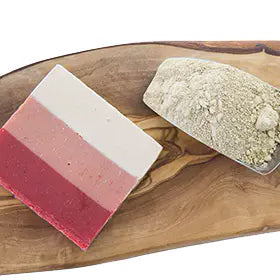Which ingredients are best for your skin? This is a hot topic. Companies spend a lot of time, money, and resources enticing consumers to buy products containing newly discovered “miracle” ingredients. Truth be told, Mother Nature has all the ingredients we need and looking to the earth itself can often solve our skin issues.
It’s important, however, to stay mindful of the whole picture. Many companies advertise the wonders of a single ingredient, neglecting to mention what else is in the bottle.
For example, a product may contain turmeric, natural alpha hydroxy acids, green tea, pure clays, or a number of other skin-loving ingredients, but that is just a piece of the picture.
Don’t be seduced by the front label. Instead, turn the product around and look at the entire ingredient list to determine if the product is truly natural, or just a chemical concoction with some turmeric thrown in.
In the industry, we call this “window dressing,” emblazoning the recognizable ingredients sought by consumers on the front to the label as well as in the ingredient list to get the consumer to ignore what else is in there and buy.
While ingredients from the earth can have a profound impact on skin, science also comes into play. Knowledge of herbs and botanicals and how they work together, plus an understanding of chemistry and skin functioning are key to creating effective products with visible results.
Being Mindful of Mother Earth
Earth Day is becoming increasingly popular and more and more people are taking time to give thanks for this amazing planet we live on and all its abundance. That said, we still have a ways to go in incorporating the earth into our skincare routines, shifting from chemical concoctions to nature’s bounty.
This day of reflection and appreciation provides an opportunity to speak for the earth, enlightening others about its transformative ingredients.
It’s also important to be mindful of the earth’s resources.
One example is the cosmetic industry’s use of palm oil, whose harvesting practices are known for wreaking havoc on the environment. Now, with sources for sustainably harvested palm oil, consumers can make a difference through our purchase decisions, supporting brands that use sustainable, organic, local, and ethical ingredients and practices.
When not using something in its purest form, it’s important to keep in mind the processes used to transform it.
For example, there are many different carriers into which botanicals are extracted. The label will likely only list the extract, but the question is what are they extracted in. One of the most common carriers is propylene glycol, which is on my list 10 Cosmetic and Skincare Ingredients to Avoid.
Another example is floral water vs. pure plant hydrosols. Some companies add a drop of essential oil, for scent, to distilled water and call it floral water.
This is not a real hydrosol or distillate. If a product has any kind of water on its ingredient list, it’s not the real deal. It should read rose hydrosol or rose distillate, for example.
Here are some of my favorite ingredients that Mother Nature has to offer:
Some of them come directly from the earth and are used in their raw forms, such as clays and muds. Others need to be dehydrated and some extracted.
- Sea salt
- Shea butter
- Olive oil
- Carrots oil, cranberry seed oil, chia seed oil, jojoba oil, safflower oil, argan oil, Evening Primrose oil, Black cumin oil, hibiscus oil
- Green, black, white, and red teas
- Probiotics
- Mushroom complex
- Turmeric
- Licorice root
- Wolfberries
- Pure clays
- Real floral waters/hydrosols
- Sea muds
- Vitamin C, A, E
- Essential fatty acids (from a natural source, such as avocado oil)
- Alpha hydroxy acid (from a natural source, such as fruit)
- Pearl powder
- Wine
Remember, it’s the sum of all the ingredients that equal the truth.

